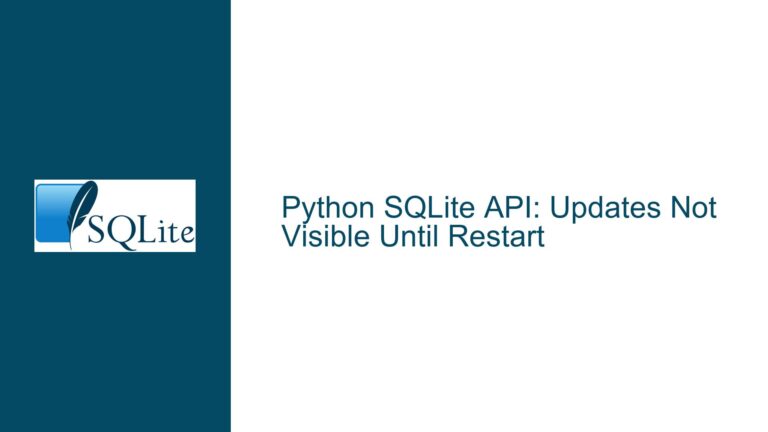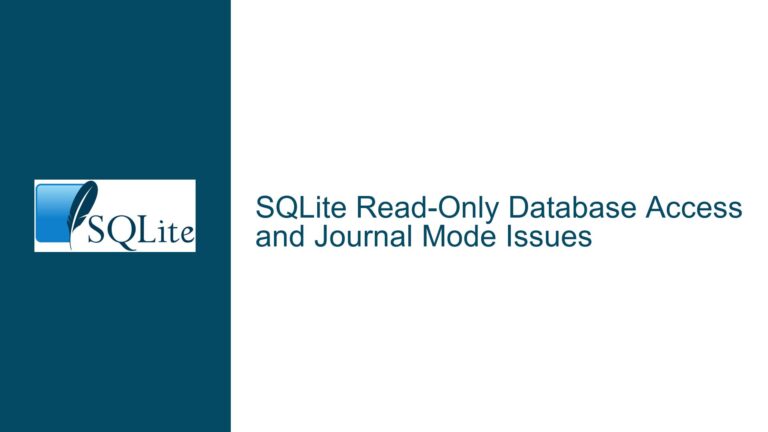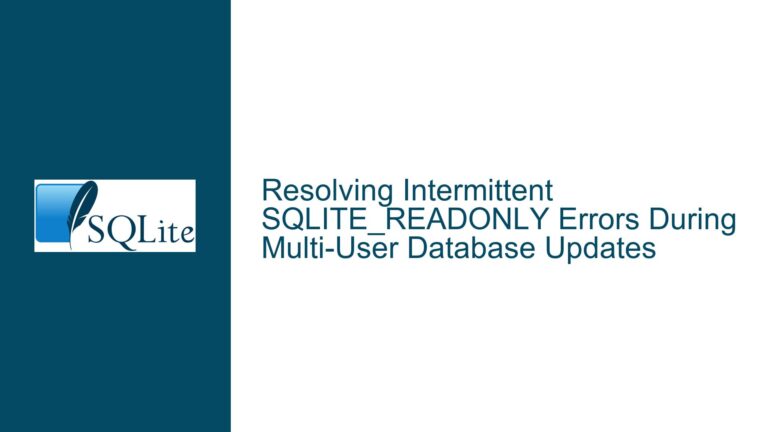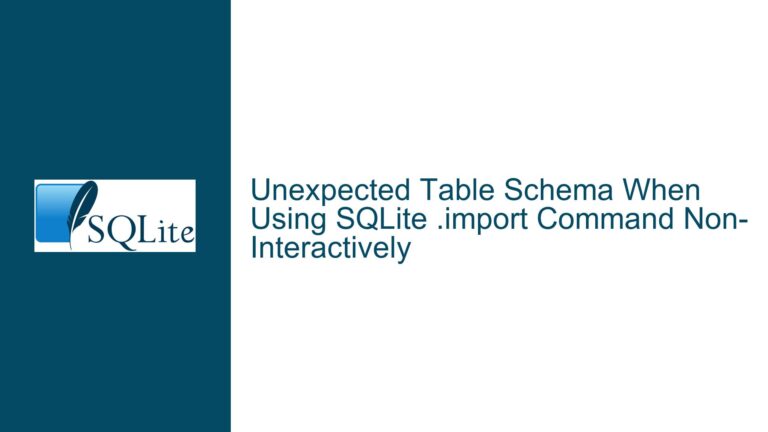Enhancing SQLite CLI with Reusable Parameterized Queries
Parameterized Query Reusability and Management in SQLite CLI
The SQLite Command-Line Interface (CLI) is a powerful tool for database exploration, schema design, and query testing. However, developers and database administrators often face inefficiencies when working with complex or repetitive queries that require parameterization. A common workflow involves repeatedly pasting query text into the CLI, adjusting parameters manually, and re-executing the modified query. This process becomes cumbersome when testing multiple query variations or parameter combinations.
The core issue revolves around the absence of a native mechanism to store named queries with parameter placeholders and execute them on demand. While the .param command allows parameter values to be set and reused across queries, there is no equivalent feature to bind these parameters to predefined query templates. This forces users to juggle between setting parameters and redefining entire queries, leading to redundant input and increased error potential.
The problem is exacerbated when queries are non-trivial, spanning multiple lines or requiring frequent adjustments. The CLI’s default behavior treats each input as a transient operation, lacking persistence for query definitions beyond the current session. This limitation hinders iterative development workflows, where rapid testing of parameterized queries against evolving datasets is critical.
Underlying CLI Architecture Limitations and Parameter Binding Constraints
The SQLite CLI’s design prioritizes simplicity and interactivity, which inherently limits its support for advanced features like stored procedures or persistent query templates. Several architectural and functional constraints contribute to the challenges of parameterized query reusability:
Transient Query Execution Model:
The CLI processes input line-by-line, executing each complete SQL statement or dot-command immediately. Queries are not stored in memory or persisted across sessions unless explicitly saved to external files. This transient model is efficient for ad-hoc operations but impractical for reusing complex queries with minor parameter adjustments.Parameter Scope and Lifetime:
The.paramcommand binds parameters at the session level, making them available to subsequent queries until cleared or reset. However, parameters are not inherently tied to specific queries. This decoupling means that changing a parameter value affects all subsequent queries referencing that parameter, which can lead to unintended side effects if not carefully managed.Lack of Query Templating:
SQLite does not support stored procedures or parameterized views in its core engine. While temporary views can encapsulate query logic, they cannot accept runtime parameters. This forces users to dynamically construct queries using string concatenation or external scripting, which introduces security risks (e.g., SQL injection) and complicates CLI-based workflows.Multiline Input Handling:
Defining multi-line queries in the CLI requires careful delimiter management. The default input handler waits for a semicolon (;) to terminate SQL statements, but this becomes ambiguous when queries contain nested semicolons (e.g., within trigger definitions or procedural code). Users often resort to external editors or workarounds to input large queries, disrupting the interactive workflow.Backward Compatibility Constraints:
As a widely adopted tool, the SQLite CLI must maintain backward compatibility with existing scripts and user habits. Introducing new features like stored query templates requires careful design to avoid breaking legacy workflows or complicating the command syntax.
Implementing Reusable Queries with .var/.x Commands, Temporary Views, and Multiline Syntax Workarounds
1. Utilizing the .var and .x Commands for Query Templating
A branch of the SQLite CLI (referred to as sqlite3x) introduces experimental commands .var and .x to address query reusability. These commands enable users to store named query templates, bind parameters, and execute them on demand.
Step-by-Step Implementation:
Defining a Query Template:
Use.var set <name> "<query>"to store a multi-line query as a shell variable. For example:.var set GetFunctions " SELECT name FROM pragma_function_list WHERE name LIKE (@prefix || '%');"The query can include parameter placeholders (e.g.,
@prefix), which are resolved using.param set.Binding Parameters:
Set parameter values with.param set <name> <value>:.param set @prefix 'sqlite'Executing the Template:
Run the stored query using.x <name>:.x GetFunctionsThis executes the query with the current parameter values, producing results as if the query were pasted directly.
Advanced Usage:
- Editing Queries In-Place:
Modify stored queries without redefining them using.var edit <name>, which opens the template in a text editor. - Chaining Commands:
Combine multiple queries or CLI operations in a single execution block:.x -s " .param set @threshold 10; SELECT * FROM logs WHERE severity > @threshold; "
Limitations:
- The
.varand.xcommands are experimental and may not be available in standard CLI distributions. - Query templates are stored in a temporary database table, so they are lost when the CLI exits unless explicitly saved.
2. Leveraging Temporary Views for Query Encapsulation
While SQLite does not support parameterized views, temporary views can encapsulate static query logic for reuse within a session.
Implementation:
Creating a Temporary View:
CREATE TEMP VIEW HighSeverityLogs AS SELECT * FROM logs WHERE severity > 5;This view persists for the session and can be queried like a regular table:
SELECT * FROM HighSeverityLogs;Dynamic Filtering with Parameters:
Combine views with parameters for limited dynamism:.param set @min_severity 7 SELECT * FROM HighSeverityLogs WHERE severity > @min_severity;
Drawbacks:
- Views cannot accept parameters directly, requiring filters to be applied post-hoc.
- Temporary views are session-scoped and must be recreated in each new CLI instance.
3. Multiline Query Input Syntax and Delimiter Strategies
Handling multi-line queries in the CLI requires careful delimiter selection to avoid premature execution.
Workarounds:
Double-Quoted Strings:
Enclose queries in double quotes to span multiple lines:.var set MyQuery " SELECT id, name FROM users WHERE status = 'active';"Caveat: Escaping internal quotes requires backslashes (e.g.,
\"), which can complicate readability.Here Document Syntax:
Use a delimiter to mark the end of a multi-line input block (not natively supported but achievable via shell scripting):.var set MyQuery <<EOF SELECT * FROM orders WHERE date BETWEEN @start AND @end; EOFThis approach depends on the host shell’s input redirection capabilities.
Line Continuation with Backslashes:
Break queries into lines using backslashes to indicate continuation:SELECT name, email \ FROM users \ WHERE last_login > @cutoff;
Best Practices:
- Use an external text editor to draft complex queries and load them via
.read <file>. - Prefer parameterized queries over string concatenation to mitigate SQL injection risks.
Conclusion:
The SQLite CLI’s extensibility through experimental commands like .var and .x provides a path toward reusable parameterized queries, while temporary views and careful input management offer interim solutions. Developers should evaluate these strategies based on their workflow complexity and the need for portability across CLI versions. As the cli_extension branch evolves, tighter integration of query templating and parameter binding could further streamline interactive database exploration.






